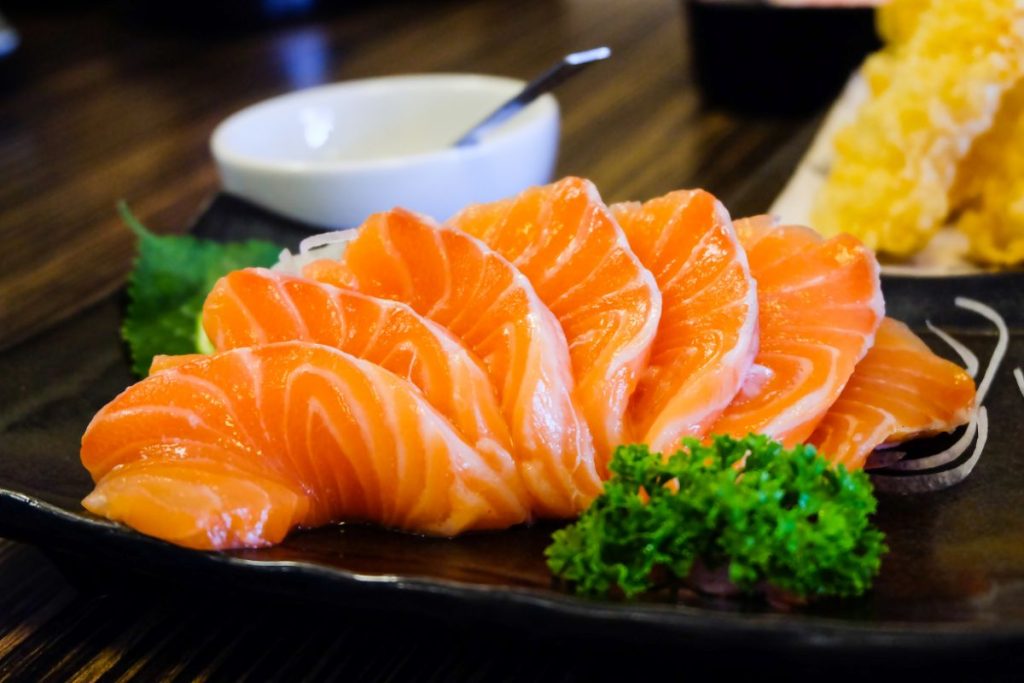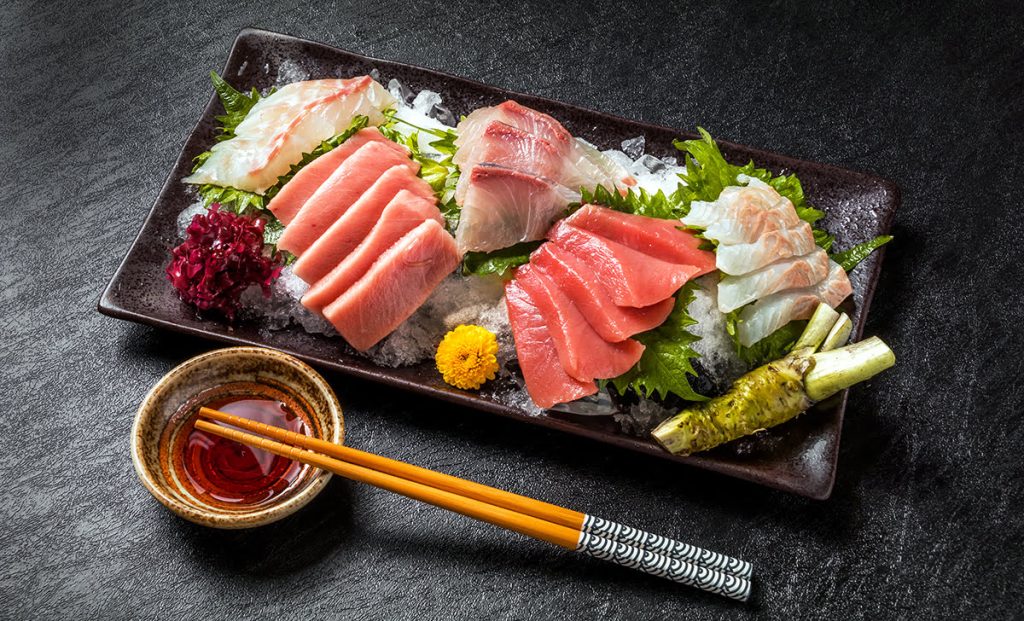Sashimi, this unique way of cooking, has long been the representative of Japanese food culture. It is not only a delicious dish, but also carries profound historical and cultural connotations. This paper will make an in-depth analysis of sashimi from the aspects of its definition, historical background and cultural significance, and discuss its influence on Japanese society, history and culture, as well as its similarities and differences with other countries’ sashimi culture.
First, the definition and historical source of Japanese Sashimi
Sashimi, or raw fish, is one of the most distinctive forms of Japanese cuisine. It cuts fresh fish, shellfish and other seafood into thin slices and is eaten with a special sauce to taste the original flavor of the ingredients. This style of cooking seems simple, but the freshness of the ingredients, the skill of the knife and the preparation of the sauce have extremely high requirements.
The history of Sashimi dates back to ancient times, when the ancestors of Japan had the habit of eating raw fish. Over time, sashimi evolved into a delicate culinary art. By the Edo period, sashimi had become a delicacy enjoyed by the upper classes, while it was rarely eaten by the common people. Until modern times, with the development of fishing and refrigeration technology, sashimi gradually became popular and became one of the representatives of Japanese cuisine.

Ii. The cultural significance and social influence of Japanese Sashimi
In Japan, sashimi is not just a food, but a cultural symbol. It embodies the Japanese reverence and value for natural ingredients, as well as the pursuit of exquisite craftsmanship. In the process of making sashimi, the masters’ exquisite knife skills and their reverence for the ingredients are the concrete embodiment of the spirit of Japanese artisans.
Sashimi also plays an important role in Japanese society. At formal and informal gatherings, sashimi is often an indispensable dish. It can not only satisfy the enjoyment of taste buds, but also narrow the distance between people and become a lubricant in social occasions.
Iii. Comparison of Sashimi in Japan and other countries
Sashimi is a cuisine most typical of Japan, but not unique to the country. Similar cuisines are found in South Korea, along the southern coast of China, and in some Southeast Asian countries. However, compared with Japanese sashimi, there are certain differences in the selection of materials, production methods and cultural significance of sashimi in these countries.
While South Korean sashimi dishes focus more on seasoning and garnishing, Japanese sashimi dishes focus more on the taste and texture of the ingredients themselves. While sashimi is also eaten on China’s southern coast, it is usually served as a snack or side dish rather than as a formal main course as in Japan.
These differences reflect the different understandings and preferences of ingredients and cuisines in different countries and regions. Through comparison, we can have a deeper understanding of the food culture and aesthetic taste in different cultural backgrounds.
Fourth, the specific application and effect of Japanese Sashimi
Take, for example, a famous Nishiku shop in Tokyo, which is known for its superb sashimi cuisine. Here, diners can taste sashimi made with a variety of fresh seafood, such as tuna, snapper, hairtail and more. Each slice of sashimi is sliced as thin as a cicada, and when dipped in a special sauce, it tastes delicious.
Sashimi also plays an important role in traditional festivals and celebrations in Japan. For example, at harvest festivals in some regions, people will make sashimi with fresh fish and seafood to celebrate the harvest and express their gratitude to nature. On these occasions, sashimi is not only a delicacy, but also a cultural symbol and an emotional bond.
As the treasure of Japanese food culture, Sashimi not only shows the Japanese people’s reverence for food ingredients and the pursuit of exquisite skills, but also reflects its unique aesthetic taste and lifestyle. By gaining insight into the history, culture and social impact of Japanese sashimi, we can better understand and appreciate this unique style of cuisine.
Looking to the future, with the deepening of globalization and cross-cultural communication, Japanese sashimi is expected to be more widely spread and recognized worldwide. At the same time, with the increasing attention to healthy eating, sashimi, a low-fat, high-protein, nutrient-rich cuisine, will also be favored by more and more people.
We should also note that Sashimi cuisine is extremely demanding in terms of freshness and quality of ingredients. In the process of promotion and popularization, how to ensure the quality and safety of food ingredients will be an important issue. In addition, how to combine the Japanese Sashimi culture with the food culture of other countries to create a more diversified cuisine is also a topic worth exploring.
Sashimi is not only a delicious cuisine, but also a treasure of Japanese culture. By gaining a deeper understanding of its history, culture and social impact, we can better appreciate this unique culinary art and look forward to its continued development in the future.
Application scenarios of Sashimi cuisine in Japan
Sashimi cuisine is widely used in Japan, from high-end restaurants to family dinners, almost everyone can see it. The following are some specific application scenarios:
High-end Japanese restaurants: In the bustling areas of Tokyo, Osaka and other cities, there are many high-end Japanese restaurants. These restaurants usually serve the freshest and highest quality seafood sashimi, such as bluefin tuna, peony shrimp, etc. Here, diners can enjoy delicate Sashimi cuisine, where each slice is carefully selected and cut and paired with a special sauce to present the ultimate delicacy.
Izakaya and night market: Sashimi is also an indispensable food in Japan’s izakaya and night market. These places offer a wide variety of sashimi at relatively affordable prices. People can taste sashimi in a relaxed atmosphere, paired with sake or beer, and enjoy food and social fun.
Family dinners and festivals: In Japan, Sashimi is often used for family dinners and festivals. Family members would head to the market together to pick fresh seafood, then return home to cut and plate it themselves. This is not only a kind of enjoyment of food, but also a kind of family reunion and the fun of making food by hand. Sashimi is an indispensable dish on the table during important festivals such as the New Year (January) or the Hungry Ghost Festival (Yelanpanga).
Business banquets and diplomatic occasions: Sashimi is also often served as a dish for distinguished guests at business banquets and diplomatic occasions. It not only represents the unique Japanese food culture, but also shows the Japanese people’s attention to food ingredients and exquisite production skills. On these occasions, the quality of sashimi and the presentation of the plate are very important to show respect and courtesy to the guests.
The influence of Sashimi cuisine on Japanese culture

As an important part of Japanese food culture, Sashimi cuisine has had a profound influence on Japanese culture. The following are the concrete manifestations of several aspects:
Enhancement of aesthetic taste: Sashimi cuisine pays attention to the original taste and beauty of ingredients, and presents works of great aesthetic value through superb cutting skills and dish art. This pursuit of beauty not only enhanced the aesthetic taste of the Japanese people, but also influenced the development of other artistic fields such as floristry and tea ceremony.
Inheritance of the craftsman spirit: Making sashimi requires exquisite craftsmanship and a wealth of experience. In Japan, many Sashimi masters master the craft after a long period of study and practice. This pursuit and inheritance of skills reflects the artisan spirit of the Japanese people and is one of the important characteristics of Japanese culture.
Philosophical thinking about nature and harmony: Sashimi cuisine emphasizes the original flavor of ingredients and the beauty of nature, which is closely related to the philosophical thinking in Japanese culture that emphasizes harmonious coexistence with nature. By tasting sashimi, people can more deeply feel the connection between ingredients and nature, which leads to thinking about nature and harmony.
Social culture: In Japan, sashimi is often served as a delicacy on social occasions. People sit together to taste sashimi and exchange feelings, which is not only a kind of enjoyment of food, but also a reflection of social culture. Through Sashimi cuisine, people can get closer to each other, improve understanding and friendship.
As the treasure of Japanese food culture, Sashimi cuisine not only satisfies people’s taste buds, but also carries rich cultural connotation and spiritual value. It plays an important role in Japanese society, history and culture, and has become a unique business card of Japanese culture.

